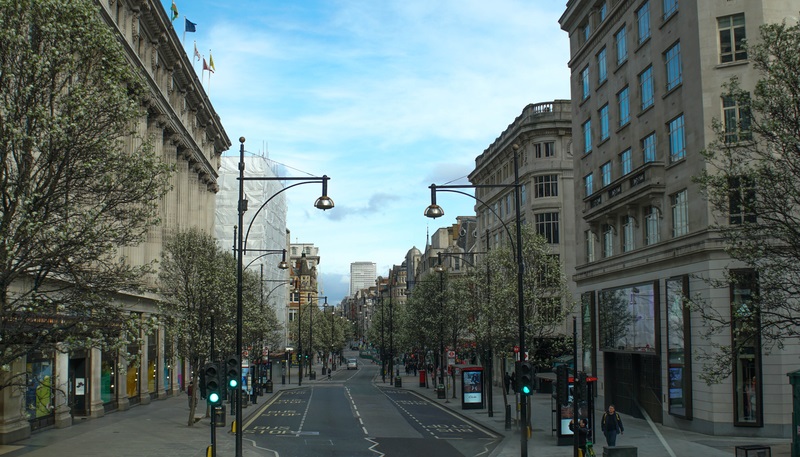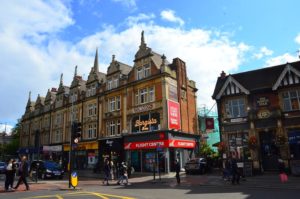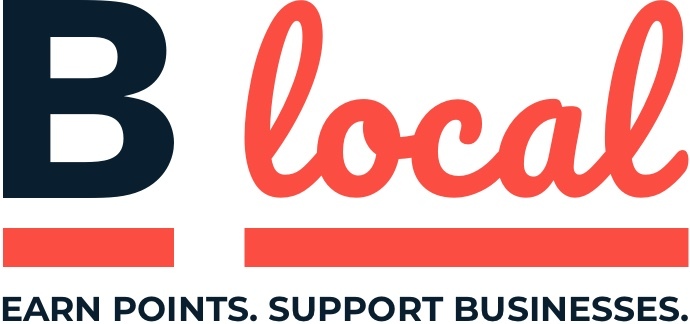
Photo: [Image taken in London during lockdown 2020] Loveandrock | Dreamstime.com
Can data reinvent the high street?
17 March 2022
by Sarah Wray
Cities are using data and new digital tools to help businesses recover from the pandemic and adapt for the future. Sarah Wray explores how these efforts are working out.
Covid-19 lockdowns and turbulence over the past two years hit high streets and urban centres hard. In some cases, businesses had already been struggling due to the growth of online shopping and other shifts. The pandemic also exacerbated this and saw businesses, from chains to independent firms, disappear or become e-commerce only.
As restrictions lift, people are returning to urban centres but for many towns and cities, it’s not business as usual. Large numbers of people still work from home at least some of the time, while others have developed new shopping habits or are seeking a different type of experience when they venture out.
The challenge for local leaders isn’t just to restore footfall; it’s to understand what’s required for high streets to thrive post-pandemic and reimagine them for the future. Many are using data and trying new digital tools as part of their strategy to achieve this.
We look at some of the latest examples from the UK and the US.
Data collective

The Greater London Authority’s High Streets Data Service, which launched in October, provides opted-in London boroughs with a range of data to give an up-to-date view of what is happening at the neighbourhood-level. Alongside open data, the subscription service incorporates data from partners, including aggregated and anonymised spend data from Mastercard and footfall data from O2, both in its raw form to enable bespoke analysis, and via a custom-built Data Explorer tool.
Ealing is one of the councils using the High Streets Data Service. Sophie Beagles, Principal Regeneration Officer at Ealing Council, says the data is being used by multiple services and acting as a “consistent evidence base” for strategies and projects, as well as for evaluation and monitoring.
It’s also feeding into town centre policy within the emerging new Local Plan for Ealing, and used to inform and monitor the footfall and spend impact of specific interventions across highways, public health, regulatory, culture, business growth and support, and regeneration.
Beagles comments: “Previously, the council purchased data ad-hoc, providing a ‘snapshot’ in time. Under the partnership, data is updated monthly and can be compared against historic data, ensuring that the council has the most up-to-date picture.”
“Data and insights are collected through the partnership using a consistent London-wide approach, enabling the council to accurately compare data across the borough and to other high streets across London,” she adds. “Collective data approaches allow for better comparisons between town centres to identify common challenges, opportunities and successes.”
Ealing Council has established a High Streets Taskforce which includes representation from officers across the council, councillors, businesses, traders’ associations, and the three business improvement districts.
“The taskforce welcomed the subscription to the partnership, and we have been able to provide them with monthly snapshots of data across the borough to keep members informed on recovery and performance in particular high streets and towns,” Beagles says.
She said the introduction of London’s roadmap out of lockdown in early 2021 initiated the start of recovery for many high streets in Ealing and by the end of the year, the majority had experienced spend levels exceeding the normal levels, with some seeing almost double pre-pandemic levels in retail spend. Footfall is generally following similar trends, slowly picking back up to meet expected levels, indicating a “gradual but positive move towards recovery”.
“Ealing Council continues to monitor the data and support businesses on its high streets as they build back better,” says Beagles. “It is vital for the council and wider stakeholders to have an accurate picture of high street activity across the borough, ensuring we can best direct resources and support businesses as they recover from the Covid-19 pandemic.”
The data partnership runs alongside other initiatives within the council including an ongoing project, funded through the Mayor of London’s Resilience Fund, working with open data consultancy Whythawk to develop a digital tool that maps and tracks vacant commercial properties across the borough.
An app for shopping local

Boston recently piloted a digital rewards programme to incentivise spending with local businesses. The city is evaluating findings to plan the next steps but Natalia Urtubey, who was Director of Small Business at the City of Boston until recently, said the results have been positive.
The partnership with Israeli tech start-up Colu, launched in April 2021, allows shoppers to earn points automatically at participating businesses when they make purchases with credit or debit cards linked to their B-Local account.
The rewards are applied as discounts at redeeming businesses. All rewards were reimbursed by the City of Boston – through US$500,000 in CARES Act funding – so there has been no cost to users or businesses.
By the end of 2021, 12,000 users signed up to the app, which Urtubey says exceeded expectations.
There was a boost in usage around the Christmas holidays and when there were special promotions – such as an initiative in October to encourage people to shop locally and use their points, with the city tripling the rewards for businesses.
A programme to welcome students back in September also drove a “huge bump” in activity.
“On the user end we were really excited because obviously at the end of the day, we need users to go out and shop locally and be spending their dollars here in our community,” says Urtubey.
On the business side, 2,200 companies signed up, of which 370 allowed points to be redeemed at their stores. Urtubey acknowledges this number is relatively low but notes that getting the programme off the ground required a lot of one-on-one support with businesses. If the programme continues, this will be scaled up to recruit more companies.
“The programme itself is super simple, but unless you get that one-on-one support, it’s tough for people to grasp the simplicity of it,” comments Urtubey.
Boston’s pilot had a particular focus on black- and brown-owned businesses, and 77 percent of the total payments through it went to black-, women- or immigrant-owned businesses, even though they were only 16 percent of the companies on the app.
“That in itself goes to show that we were driving residents to really shop locally,” says Urtubey.
A future development for the app could be expanding participation options for online and cash-only businesses.
Another feature the team would like to further develop is the use of the app to help people “get to know their neighbourhoods in different ways,” including through profiles of local businesses.
“This app has shown us that once people get to know the businesses, they are really excited to go visit them and then once they’re in a new neighbourhood, they can explore,” says Urtubey. “The way in which users were engaging with the content was really critical.”
Should the programme continue, the city also plans to do more around highlighting events and occasions that can bring people into the neighbourhood.
Such content and marketing developments take resources, though, and this will be a key consideration for the next phase.
“It’s a lot of work,” Urtubey says, adding that the hope would be to be able to dedicate more capacity in future.
The ultimate vision further down the line would be to use the app to gather resident feedback on what they want to see from businesses, main streets and commercial districts.
While people can currently still use the app, the points system is paused until a decision is made about the future, including sustainable long-term funding options.
The city of Akron in Ohio launched its Akronite app with Colu in August 2020 to increase civic and community engagement, support female- and minority-owned businesses, and help residents connect with local retailers. A report in December said that since the launch more than 6,300 users and 270 local businesses have participated and the app has also generated US$1.18 million of local economic impact.
“The Akronite app was initially envisioned as a way to help our local businesses get through the crushing impact of the pandemic, but has proven to be a successful effort to promote and highlight Akron owned businesses,” said Akron Mayor Dan Horrigan. “We plan to continue the app into 2022 to further support our small business community and encourage our residents to spend locally.”
Talking to the street

As part of its support for high street recovery, the Royal Borough of Windsor and Maidenhead in Berkshire, England is using a citizen engagement tool called Hello Lamp Post. Residents and visitors in Windsor town centre can ‘talk’ to street furniture, bollards, public art and more via SMS, WhatsApp, and Facebook Messenger to ask questions or provide feedback that can help inform local recovery plans.
The council can also use the system to deliver information about local events, future development plans, tell the story or history of a statue or place, share live transport times, or provide any Covid-19 guidance.
The pilot was originally part of the local authority’s ‘Rediscover Your Royal Borough’ reopening campaign, aiming to reassure residents and encourage them to come into the town centre and explore.
Steph James, Service Lead for Economic Growth at the Royal Borough of Windsor and Maidenhead, says: “Certainly as a result of Covid, as a local authority, we want to look at other ways of engaging our residents, and making sure we’re reaching out in many different ways. Covid made everyone realise that there were vulnerable people within the community that maybe were hidden, especially when shielding was in place.”
With the pilot due to conclude next month, the council is looking at how the tool could be potentially integrated into more services, such as to engage with people about street cleaning or parks and open spaces.
In February, James said town centre footfall was returning almost to pre-pandemic levels, but property vacancy rates remained higher than before, with retail particularly hard hit.
“But we’ve seen an upsurge in food and drink venues opening,” she said. “People want the experience of coming out to socialise rather than that traditional retail experience.”
Hello Lamp Post is part of an overall strategy to support existing businesses and make the street scene and public realm as good as it can be. This has also included helping firms prepare for the Queen’s Platinum Jubilee celebrations in June and providing innovation grants and business training support.
“We’re making sure that post-COVID businesses are being upskilled to be not just bricks and mortar, but make sure that the digital side of their businesses is up to date, and that they’re engaging with social media,” James says.
Another key focus is promoting the local area to residents as well as the tourist market.
Through Hello Lamp Post the borough can ask residents and visitors for input on issues such as what types of businesses and events they’d like to see and their ideal opening hours, and this can be fed back to companies. Responses have seen calls for improved street cleaning and more markets and events, for example.
Feedback and footfall counters also show that the trend to continue working from home has had an impact on the lunchtime trade in Maidenhead, for instance, but evenings are busier when people might now want to get out and about more.
This has driven the creation of a night-time economy strategy group and gives businesses information and insights, although it can be hard to change behaviours in terms of opening hours, James notes.
As is always the case, data and digital tools alone won’t fix a complex problem, but they are giving cities and businesses fresh ways to understand the ‘new normal’ and the opportunity to adapt to whatever shifts are coming next in a more agile way.











